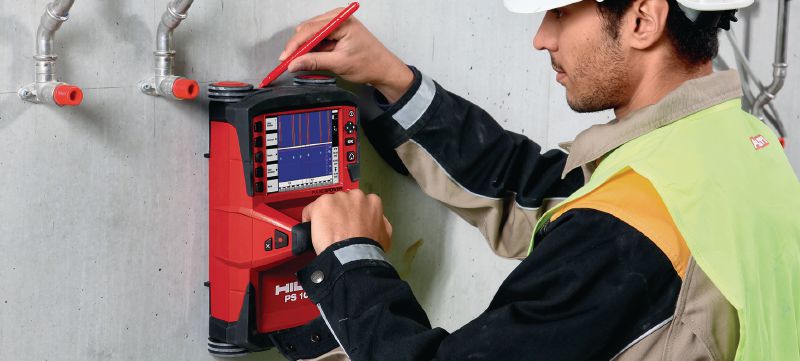RainierGPR Concrete Scanning: Expert Insights and Finest Practices
RainierGPR Concrete Scanning: Expert Insights and Finest Practices
Blog Article
Harness the Strategic Side of Concrete Scanning for Unparalleled Project Success and Quality Control
In the realm of contemporary construction and infrastructure development, the utilization of concrete scanning technology has actually arised as a critical device for making sure task success and keeping top quality standards. The true power of concrete scanning lies not just in its ability to improve project outcomes but additionally in its ability to transform traditional practices, establishing a brand-new criteria for accuracy and effectiveness in the building and construction industry.
The Relevance of Concrete Scanning
Concrete scanning is an important action in building and construction jobs to make certain the safety and stability of structures. By making use of numerous scanning technologies such as Ground Passing Through Radar (GPR) and electromagnetic induction, construction groups can non-destructively review the subsurface of concrete structures to identify prospective hazards like rebar, conduits, or post-tension wires. This details is important for job service providers, designers, and managers to make educated decisions and stay clear of pricey blunders throughout the building and construction process.
Among the primary reasons concrete scanning is so essential is its capability to avoid crashes and injuries on the building site. Unintentionally puncturing an online electric conduit or damaging post-tension cable televisions can have tragic repercussions, not only in regards to safety and security however additionally in terms of project hold-ups and economic effects. By carrying out thorough concrete scanning before any kind of drilling, reducing, or coring tasks, building and construction groups can mitigate threats and develop a safer working atmosphere for every person included.
Along with safety considerations, concrete scanning likewise plays a key role in guaranteeing the lasting resilience and quality of the framework. By finding any kind of anomalies or flaws concealed under the surface, such as voids or delamination, very early intervention can be implemented to address these problems prior to they escalate into more significant troubles. Eventually, spending in concrete scanning is a proactive measure that can save time, money, and sources in the future, while additionally supporting the highest criteria of construction quality.
Advanced Modern Technology for Exact Results

By incorporating these innovative innovations right into concrete scanning techniques, building groups can simplify operations, lower task delays, and ensure the overall top quality and success of the project. The precision and performance provided by these tools contribute substantially to the project's success by promoting notified decision-making and enhancing top quality assurance steps.
Enhancing Project Efficiency and Timelines

Moreover, concrete scanning makes it possible for groups to identify architectural weaknesses and possible dangers beforehand, enabling for prompt remediation and preventing crashes that could derail job timelines. The real-time data supplied by scanning tools helps click for info with informed decision-making, bring about smoother control amongst different trades and stakeholders. This enhanced collaboration reduces disputes, boosts productivity, and ultimately accelerates project distribution.
Moreover, by proactively addressing issues via concrete scanning, construction teams can comply with schedules better, reduce downtime, and maximize resource allocation. The capability to identify covert barriers and verify structural stability successfully adds to general job efficiency and timelines, ensuring successful end results and client complete satisfaction.
Ensuring Safety And Security and Threat Mitigation

Risk mitigation methods can be boosted with the in-depth details given by concrete scanning, making it possible for task teams to make educated decisions that reduce the chance of unexpected incidents. Additionally, by precisely drawing up subsurface conditions, service providers can stay clear of expensive rework, hold-ups, and damages to existing frameworks, additionally adding to general job safety and security and success. Implementing concrete scanning as a routine technique not just guarantees a more secure work atmosphere yet additionally imparts self-confidence in stakeholders pertaining to the task's dedication to high quality and danger monitoring.
Quality Control With Concrete Scanning
Concrete scanning plays a critical role in promoting high quality assurance standards within construction jobs. By using innovative scanning innovations such as Ground Penetrating Radar (GPR) and Concrete X-ray, job supervisors and engineers can make certain the stability and high quality of concrete frameworks. With concrete scanning, potential problems, such as voids, splits, or enhancing bar congestion, can be detected non-destructively, permitting prompt treatments to maintain the architectural integrity of the task.
Quality assurance through concrete scanning not only aids my link in recognizing existing problems yet likewise makes it possible for aggressive actions to stop future problems that can compromise the security and longevity of the framework. By conducting detailed scans at essential stages of building and construction, teams can verify the precision of architectural strategies, confirm the positioning of essential elements, and deal with any type of discrepancies immediately. This aggressive strategy reduces rework, lowers costly hold-ups, and inevitably brings about the distribution of high-quality, resilient frameworks that exceed or meet sector criteria.
Conclusion
In conclusion, concrete scanning plays a crucial function in guaranteeing job success, top quality, safety, and performance assurance. The critical side supplied by concrete scanning enables for aggressive threat reduction and boosts general task monitoring.
In the world of contemporary building and construction and framework growth, the usage of concrete scanning modern technology has actually emerged as a crucial device for guaranteeing task success and preserving quality criteria. By integrating these advanced modern technologies into concrete scanning techniques, building and construction groups can simplify process, decrease job delays, and make certain the general high quality and success of the job.Offered the essential nature of job performance and timelines in building and construction monitoring, the focus now shifts in the direction of ensuring safety and mitigating risks within the project setting.Concrete scanning plays a pivotal role in promoting quality assurance requirements within construction projects. By utilizing sophisticated scanning technologies such as Ground Permeating Radar (GPR) and Concrete X-ray, job supervisors and designers can ensure the integrity and quality of concrete structures.
Report this page